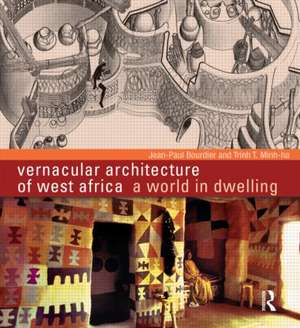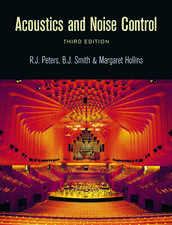Vernacular Architecture of West Africa: A World in Dwelling
Autor Jean-Paul Bourdier, Trinh T. Minh-Haen Limba Engleză Hardback – 14 mar 2011
This cultural dimension and its realization through different architectural practices are illustrated in this work with examples taken from dwellings across numerous ethnic groups in sub-Saharan West Africa.
Drawings, plans, axonometric projections, and photographs show the beauty and complexity of this architecture that is a spiritual praxis—as much place of life as work of art.
Preț: 772.36 lei
Preț vechi: 1107.58 lei
-30% Nou
Puncte Express: 1159
Preț estimativ în valută:
147.79€ • 154.86$ • 122.18£
147.79€ • 154.86$ • 122.18£
Carte tipărită la comandă
Livrare economică 12-26 aprilie
Preluare comenzi: 021 569.72.76
Specificații
ISBN-13: 9780415585439
ISBN-10: 0415585430
Pagini: 192
Ilustrații: 500 color images
Dimensiuni: 227 x 245 x 23 mm
Greutate: 0.91 kg
Ediția:New.
Editura: Taylor & Francis
Colecția Routledge
Locul publicării:Oxford, United Kingdom
ISBN-10: 0415585430
Pagini: 192
Ilustrații: 500 color images
Dimensiuni: 227 x 245 x 23 mm
Greutate: 0.91 kg
Ediția:New.
Editura: Taylor & Francis
Colecția Routledge
Locul publicării:Oxford, United Kingdom
Public țintă
General, Postgraduate, Professional, Professional Practice & Development, and UndergraduateCuprins
Acknowledgements. Introduction Part 1: Dweller, Dwelling, and Setting Part 2: Cultural Framework 1. House as Project of Identity: Picturing Soninke Dwellings 2. House as Inside and Outside: Picturing Kassena Dwellings 3. House as Assurance of Social Viability: Picturing Moba Dwellings 4. House as Vessel of Day and Night: Picturing Nuna Dwellings 5. House as Life-Giving Speech: Picturing Jaxanke, Ko, and Mandingo Dwellings 6. House as Creative Source: Picturing Puguli and Bassari Dwellings 7. House as Newborn: Picturing Kusasi and Birifor Dwellings 8. House and Differential Space: Picturing Moor Dwellings 9. House in the World’s Image: Picturing Batammaliba Dwellings Part 3: Architectural Practices 10. Terrace-Roofed Dwellings Nankani Dwelling. Lyela Dwelling. Dogon Cliff Dwelling. Tokolor Dwelling. Tokolor Mosques 11. Thatch-Roofed Dwellings Konkomba Dwelling. Toffinu Lake Dwelling. Sereer Dwelling. Joola Impluvium Dwelling. Calabash Dome: Fulbe Dwelling. Bibliography
Notă biografică
An architect, painter, photographer, film producer and production designer, Jean-Paul Bourdier is Professor of Architecture at the University of California, Berkeley. He has published several books on vernacular architecture, notably Drawn from African Dwellings and African Spaces: Design for Living in Upper-Volta. His work in land art, body art and photography has been the object of numerous expositions and received many prizes. Some of his work in this area has been gathered in his most recent book, Bodyscapes.
Trinh T. Minh-ha is Professor of Rhetoric and of Gender and Women’s Studies at the University of California, Berkeley. A cultural critic, a feminist and postcolonial theorist as well as a filmmaker, visual artist, writer and composer, she is the author of several books including Woman Native Other, When the Moon Waxes Red, Framer Framed, Cinema Interval, The Digital Film Event, and most recently, Elsewhere, Within Here. Her work also includes seven feature-length films (including Naked Spaces – Living is Round, Surname Viet Given Name Nam, Shoot for the Contents, and Night Passage) that have been honored in many retrospectives worldwide.
Trinh T. Minh-ha is Professor of Rhetoric and of Gender and Women’s Studies at the University of California, Berkeley. A cultural critic, a feminist and postcolonial theorist as well as a filmmaker, visual artist, writer and composer, she is the author of several books including Woman Native Other, When the Moon Waxes Red, Framer Framed, Cinema Interval, The Digital Film Event, and most recently, Elsewhere, Within Here. Her work also includes seven feature-length films (including Naked Spaces – Living is Round, Surname Viet Given Name Nam, Shoot for the Contents, and Night Passage) that have been honored in many retrospectives worldwide.
Descriere
The living environments of hundreds of African ethnic groups offer a variety of ideas and construction practices which contradict the over-played image of primitive huts that have come to represent rural Africa. The cultural dimension and its application using different architectural practices are fantastically illustrated in this work, with examples taken from the habitats of different ethnic groups of south and west Africa.








